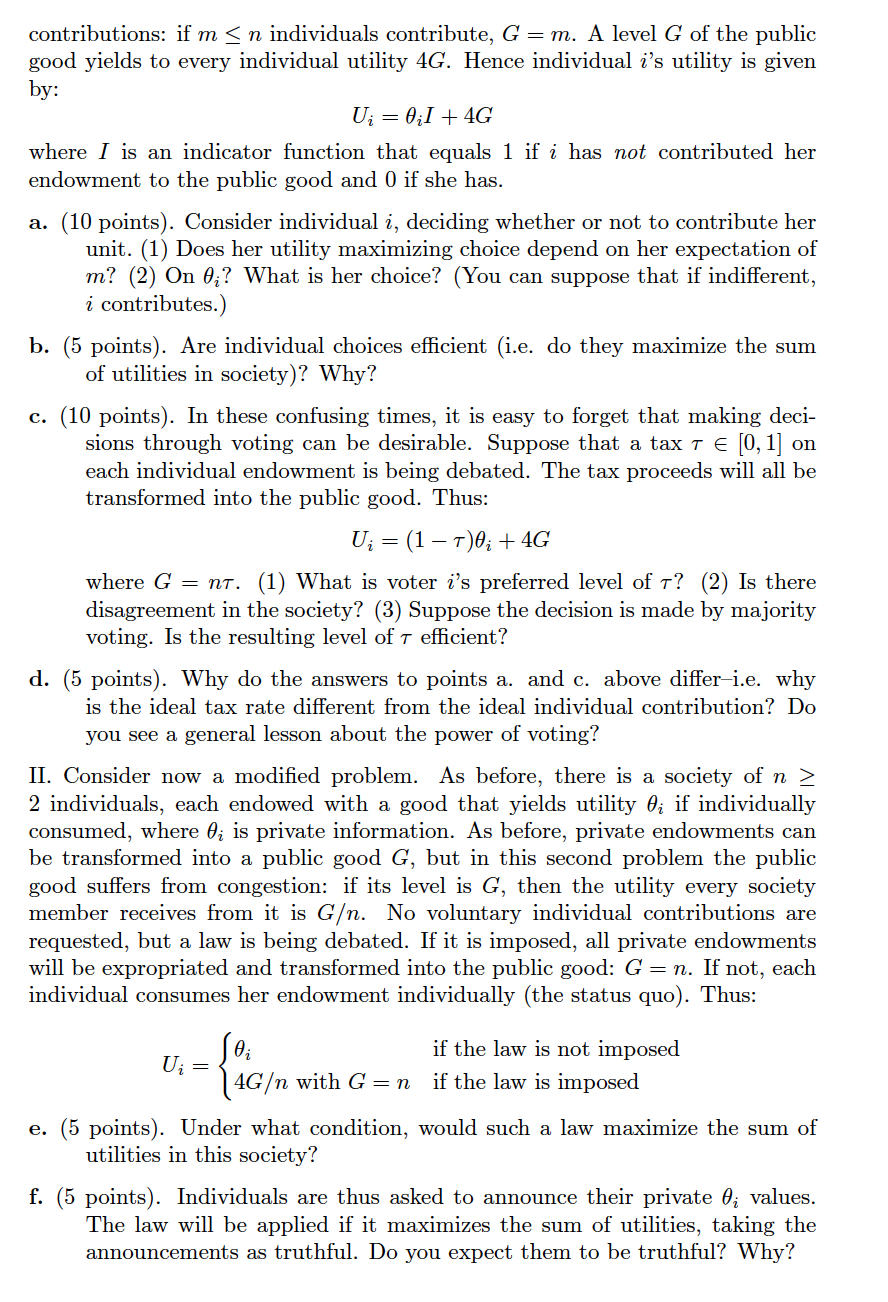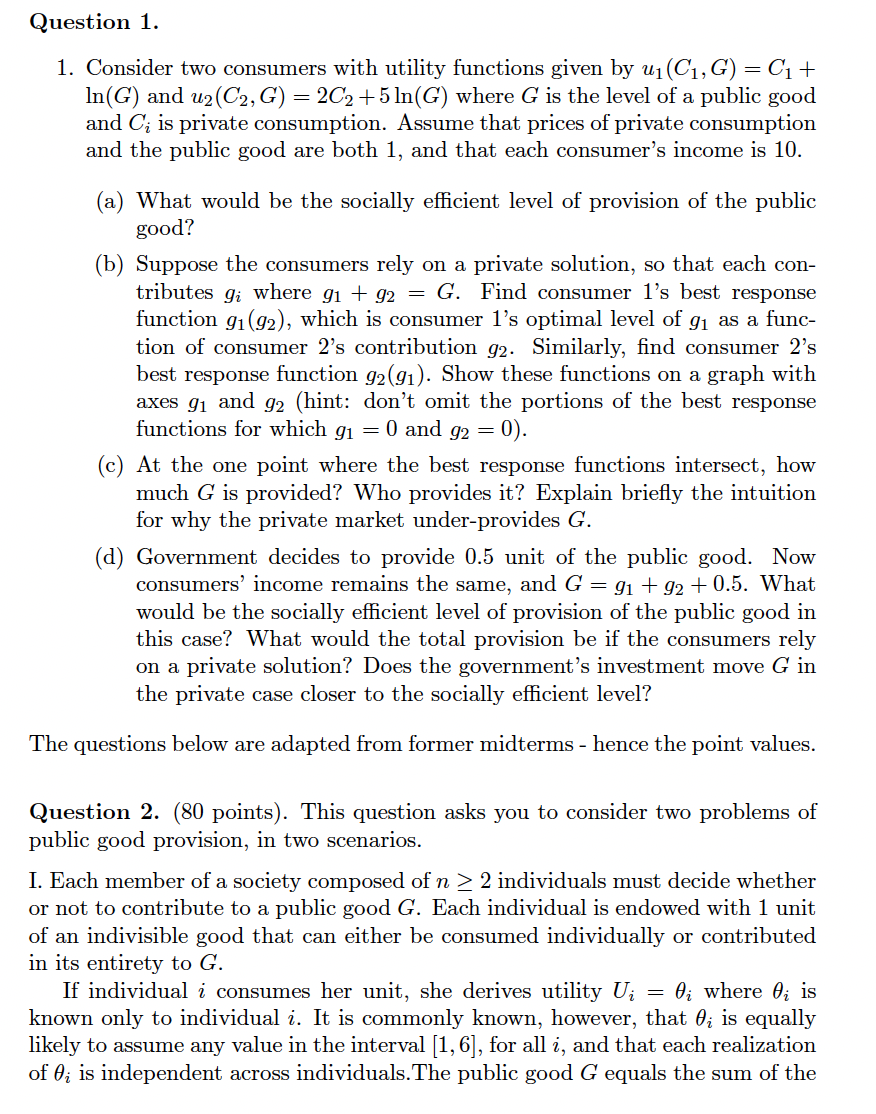

contributions: if mn individuals contribute, G=m. A level G of the public good yields to every individual utility 4G. Hence individual i 's utility is given by: where I is an indicator function that equals 1 if i has not contributed her endowment to the public good and 0 if she has. a. (10 points). Consider individual i, deciding whether or not to contribute her unit. (1) Does her utility maximizing choice depend on her expectation of m ? (2) On i ? What is her choice? (You can suppose that if indifferent, i contributes.) b. (5 points). Are individual choices efficient (i.e. do they maximize the sum of utilities in society)? Why? c. (10 points). In these confusing times, it is easy to forget that making decisions through voting can be desirable. Suppose that a tax [0,1] on each individual endowment is being debated. The tax proceeds will all be transformed into the public good. Thus: Ui=(1)i+4G where G=n. (1) What is voter i 's preferred level of ? (2) Is there disagreement in the society? (3) Suppose the decision is made by majority voting. Is the resulting level of efficient? d. (5 points). Why do the answers to points a. and c. above differ-i.e. why is the ideal tax rate different from the ideal individual contribution? Do you see a general lesson about the power of voting? II. Consider now a modified problem. As before, there is a society of n 2 individuals, each endowed with a good that yields utility i if individually consumed, where i is private information. As before, private endowments can be transformed into a public good G, but in this second problem the public good suffers from congestion: if its level is G, then the utility every society member receives from it is G. No voluntary individual contributions are requested, but a law is being debated. If it is imposed, all private endowments will be expropriated and transformed into the public good: G=n. If not, each individual consumes her endowment individually (the status quo). Thus: Ui={i4GwithG=nifthelawisnotimposedifthelawisimposed e. (5 points). Under what condition, would such a law maximize the sum of utilities in this society? f. (5 points). Individuals are thus asked to announce their private i values. The law will be applied if it maximizes the sum of utilities, taking the announcements as truthful. Do you expect them to be truthful? Why? uestion 1. 1. Consider two consumers with utility functions given by u1(C1,G)=C1+ ln(G) and u2(C2,G)=2C2+5ln(G) where G is the level of a public good and Ci is private consumption. Assume that prices of private consumption and the public good are both 1 , and that each consumer's income is 10 . (a) What would be the socially efficient level of provision of the public good? (b) Suppose the consumers rely on a private solution, so that each contributes gi where g1+g2=G. Find consumer 1's best response function g1(g2), which is consumer 1's optimal level of g1 as a function of consumer 2's contribution g2. Similarly, find consumer 2's best response function g2(g1). Show these functions on a graph with axes g1 and g2 (hint: don't omit the portions of the best response functions for which g1=0 and g2=0 ). (c) At the one point where the best response functions intersect, how much G is provided? Who provides it? Explain briefly the intuition for why the private market under-provides G. (d) Government decides to provide 0.5 unit of the public good. Now consumers' income remains the same, and G=g1+g2+0.5. What would be the socially efficient level of provision of the public good in this case? What would the total provision be if the consumers rely on a private solution? Does the government's investment move G in the private case closer to the socially efficient level? ie questions below are adapted from former midterms - hence the point values. uestion 2. (80 points). This question asks you to consider two problems of blic good provision, in two scenarios. Each member of a society composed of n2 individuals must decide whether not to contribute to a public good G. Each individual is endowed with 1 unit an indivisible good that can either be consumed individually or contributed its entirety to G. If individual i consumes her unit, she derives utility Ui=i where i is own only to individual i. It is commonly known, however, that i is equally ely to assume any value in the interval [1,6], for all i, and that each realization i is independent across individuals. The public good G equals the sum of the contributions: if mn individuals contribute, G=m. A level G of the public good yields to every individual utility 4G. Hence individual i 's utility is given by: where I is an indicator function that equals 1 if i has not contributed her endowment to the public good and 0 if she has. a. (10 points). Consider individual i, deciding whether or not to contribute her unit. (1) Does her utility maximizing choice depend on her expectation of m ? (2) On i ? What is her choice? (You can suppose that if indifferent, i contributes.) b. (5 points). Are individual choices efficient (i.e. do they maximize the sum of utilities in society)? Why? c. (10 points). In these confusing times, it is easy to forget that making decisions through voting can be desirable. Suppose that a tax [0,1] on each individual endowment is being debated. The tax proceeds will all be transformed into the public good. Thus: Ui=(1)i+4G where G=n. (1) What is voter i 's preferred level of ? (2) Is there disagreement in the society? (3) Suppose the decision is made by majority voting. Is the resulting level of efficient? d. (5 points). Why do the answers to points a. and c. above differ-i.e. why is the ideal tax rate different from the ideal individual contribution? Do you see a general lesson about the power of voting? II. Consider now a modified problem. As before, there is a society of n 2 individuals, each endowed with a good that yields utility i if individually consumed, where i is private information. As before, private endowments can be transformed into a public good G, but in this second problem the public good suffers from congestion: if its level is G, then the utility every society member receives from it is G. No voluntary individual contributions are requested, but a law is being debated. If it is imposed, all private endowments will be expropriated and transformed into the public good: G=n. If not, each individual consumes her endowment individually (the status quo). Thus: Ui={i4GwithG=nifthelawisnotimposedifthelawisimposed e. (5 points). Under what condition, would such a law maximize the sum of utilities in this society? f. (5 points). Individuals are thus asked to announce their private i values. The law will be applied if it maximizes the sum of utilities, taking the announcements as truthful. Do you expect them to be truthful? Why? uestion 1. 1. Consider two consumers with utility functions given by u1(C1,G)=C1+ ln(G) and u2(C2,G)=2C2+5ln(G) where G is the level of a public good and Ci is private consumption. Assume that prices of private consumption and the public good are both 1 , and that each consumer's income is 10 . (a) What would be the socially efficient level of provision of the public good? (b) Suppose the consumers rely on a private solution, so that each contributes gi where g1+g2=G. Find consumer 1's best response function g1(g2), which is consumer 1's optimal level of g1 as a function of consumer 2's contribution g2. Similarly, find consumer 2's best response function g2(g1). Show these functions on a graph with axes g1 and g2 (hint: don't omit the portions of the best response functions for which g1=0 and g2=0 ). (c) At the one point where the best response functions intersect, how much G is provided? Who provides it? Explain briefly the intuition for why the private market under-provides G. (d) Government decides to provide 0.5 unit of the public good. Now consumers' income remains the same, and G=g1+g2+0.5. What would be the socially efficient level of provision of the public good in this case? What would the total provision be if the consumers rely on a private solution? Does the government's investment move G in the private case closer to the socially efficient level? ie questions below are adapted from former midterms - hence the point values. uestion 2. (80 points). This question asks you to consider two problems of blic good provision, in two scenarios. Each member of a society composed of n2 individuals must decide whether not to contribute to a public good G. Each individual is endowed with 1 unit an indivisible good that can either be consumed individually or contributed its entirety to G. If individual i consumes her unit, she derives utility Ui=i where i is own only to individual i. It is commonly known, however, that i is equally ely to assume any value in the interval [1,6], for all i, and that each realization i is independent across individuals. The public good G equals the sum of the








